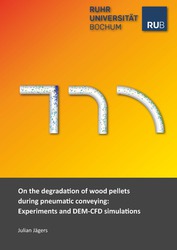| Areas | |
|---|---|
| Serie de libros (96) |
1379
|
| Nachhaltigkeit |
3
|
| Gesundheitswesen |
1
|
| Letra |
2367
|
| Ciencias Naturales |
5407
|
| Ciencias Ingeniería |
1793
|
| Ingeniería | 292 |
| Ingeniería mecánica y de proceso | 862 |
| Ingeniería eléctrica | 686 |
| Mineria y metalurgía | 30 |
| Arquitectura e ingeniería civil | 75 |
| General |
98
|
|
Leitlinien Unfallchirurgie
5. Auflage bestellen |
|
Erweiterte Suche
On the degradation of wood pellets during pneumatic conveying: Experiments and DEM-CFD simulations (Tienda española)
Julian Jägers (Autor)Previo
Lectura de prueba, PDF (420 KB)
Indice, PDF (27 KB)
Die Zerkleinerung von Holzpellets und damit die Entstehung von Feinanteil während des pneumatischen Transports wird zusammen mit den auftretenden Druckverluste im Rahmen dieser Arbeit experimentell und numerisch untersucht. Zunächst erfolgt die Entwicklung eines empirischen Bruchmodells auf Basis von Einzelpartikelprallversuchen zur statistischen Beschreibung des Bruchverhaltens von Holzpellets in Abhängigkeit von Kenngrößen wie Partikellänge, Aufprallgeschwindigkeit und -Winkel. Die entwickelten Korrelationen werden in den hauseigenen DEM-Code des Lehrstuhls für Energieanlagen und Energieprozesstechnik der Ruhr-Universität Bochum implementiert. Gekoppelte DEM-CFD Simulationen geben detaillierte Einblicke in die Abhängigkeiten der Strömungsverhältnisse sowie des Bewegungsverhaltens und der mechanischen Belastungen der geförderten Partikel von Betriebsbedingungen und Leitungskomponenten. Die numerischen Ergebnisse stimmen qualitativ mit denen korrespondierender Experimente überein und zeigen die Erhöhung von Pelletbruch und Feinanteil durch zunehmende Förderluftströme bzw. abnehmende Pelletmassenströme und kleinere Krümmerradien. Das entwickelte Bruchmodel ermöglicht detaillierte Untersuchungen pneumatischer Fördervorgänge und die Auslegung schonender Betriebsbedingungen und Leitungskomponenten zur Reduzierung von Druckverlusten sowie Pelletbruch und Feinanteil.
In the present thesis, the dependence of wood pellet degradation and fines formation during pneumatic conveying on operating conditions like air and product mass flow or shape of pipe components is investigated. Both the size reduction of the cylindrical pellets during pneumatic transport caused by mechanical impacts and the prevailing pressure losses are analysed experimentally and numerically. Single particle impact tests are performed for investigating the breakage behaviour of wood pellets including the effect of particle length, impact velocity and collision angle. Based on the empirical correlations derived, a numerical degradation model is developed and implemented into the in-house DEM code of the Department of Energy Plant and Technology of the Ruhr-University Bochum. Experimental and numerical investigations are conducted using coupled DEM-CFD simulations to obtain detailed insights into flow conditions, particle motion and the mechanical loads on the pellets during pneumatic conveying. Numerical results show good qualitative agreement with the experimentally determined degradation rates and prevailing pressure losses. The degradation model developed allows detailed investigation into wood pellet degradation and fines formation during pneumatic conveying and enables the design of pipe configurations and operating conditions to prevent particle size reduction and excessive pressure losses.
| ISBN-13 (Impresion) | 9783736973718 |
| ISBN-13 (E-Book) | 9783736963719 |
| Formato | A5 |
| Idioma | Inglés |
| Numero de paginas | 192 |
| Laminacion de la cubierta | mate |
| Edicion | 1 |
| Lugar de publicacion | Göttingen |
| Lugar de la disertacion | Bochum |
| Fecha de publicacion | 22.02.2021 |
| Clasificacion simple | Tesis doctoral |
| Area |
Ingeniería mecánica y de proceso
Ingeniería de energía |
| Palabras claves | Holzpellets, Wood pellets, Feinanteil, Fines, fine fraction, Qualitätssicherung, Quality assurance, Pneumatische Auslieferung, Pneumatic delivery, Pelletfahrzeug, Pellet truck, silo truck, Pelletbruch, Pelletbreakage, Mechanische Festigkeit, Mechanical Durability, Förderzustände, Conveying modes, Pelletschleuse, Pellet lock, Pneumatische Förderung, Pneumatic conveying, Druckverlust, Pressure loss, Beladung, Solids loading ratio, Rohrkrümmer, Pipe bend, Wandbelastungen, Wall erosion, Partikelzerkleinerung, Particle degradation, Zerkleinerungsverhalten, Degradation characteristics, Bruchwahrscheinlichkeit, Breakage probability, selection function, Bruchstückgrößenverteilung, Breakage function, Bruchmodell, Degradation model, Einzelpartikelprallversuche, Single particle impact tests, Zerkleinerungsgrad, Crushing ratio, Diskrete Elemente Methode, Discrete Element Method, DEM, Strömungssimulation, Computational Fluid Dynamics, CFD, Gekoppelte DEM-CFD Simulation, Coupled DEM-CFD approach, DEM Materialparameter, DEM material parameter, Quaternionen, Quaternions, Kontaktstatistiken, Collision statistics, Spherozylinder, Spherocylinder, Nicht-sphärische Partikel, Non-spherical particles, Widerstandsbeiwert, Drag coefficient, Anströmfläche, Cross-sectional area, Partikel-Fluid-Interaktionen, Particle-fluid interactions, Fallschachtversuche, Drop shaft tests, Partikeleintrittsgeschwindigkeit, Particle inlet velocity, Euler-Langrange-Modellierungsansatz, Euler-Lagrange approach, Digitale Bildauswertung, Digital image analysis, Stereoskopisches Partikeltracking, Stereoscopic particle tracking, Partikeldetektion und Erkennung, Particle detection and seperation, Automatisierte Längenmessung, Automated length measurement, Größenverteilung, Size distribution |
| URL para pagina web externa | http://www.leat.rub.de/index.php?do=promotionen.htm |








